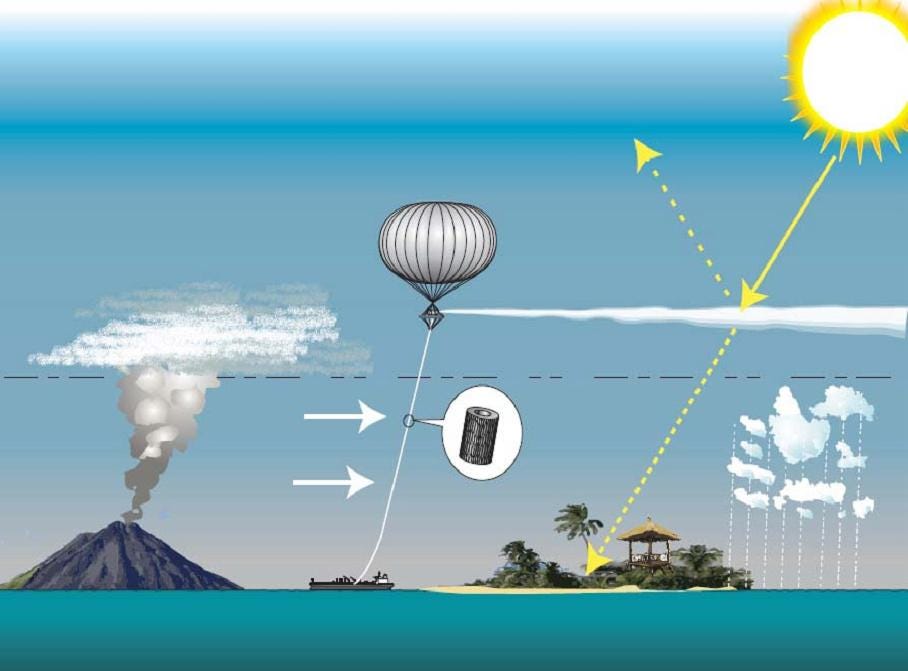Climate tech’s biggest trouble-maker: an interview with Andrew Song of Make Sunsets
July 31, 2024 edition of Plan B Post.
This week, an exclusive Plan B Post interview with a man Time magazine calls climate tech’s biggest troublemaker: Andrew Song, Co-founder of Make Sunsets.
In the future, when they write the history of humanity’s battle with climate change, one unlikely pair will stand out for their irreverence and ability to get things done: Make Sunsets’s Luke Iseman and Andrew Song.
They seem to be the only ones regularly releasing tiny particles into the high atmosphere to reflect sunlight and cool the earth. This technique is called stratospheric aerosol injection, or SAI, and has been the subject of extensive research and discussion. But only Luke and Andrew have been doing it, on their own, from a mobile home, for over two years.
Neither is a scientist, but they’ve assumed the iconoclastic tradition of experimental researchers like Jane Goodall, Gregor Mendel, and Benjamin Franklin.
Song and Iseman used common sense to address the problem of slow action on climate change. They knew, from the example of Mount Pinatubo's 1991 eruption and the research, that SAI could cool the earth at a relatively low cost. They began by releasing sulfur dioxide-filled balloons into the upper stratosphere.
I’m grateful Andrew made time for a Plan B Post interview.
Plan B Post: Andrew, when Make Sunsets burst onto the scene, it felt radically different. What need is Make Sunsets trying to solve?
Andrew: We realized climate change is here, but we do have time to make a difference. The science shows stratospheric aerosol injection is an effective solution to buy time. We decided to fund a sustainable SAI effort by selling cooling credits to consumers who want to offset their carbon emissions.
Plan B Post: Have you tried selling to corporate customers?
Andrew: Yes, that option is open. This is new and controversial for corporations. It needs bold leaders to say, 'We're not hitting our sustainability goals for 2030 or 2050, and we have to do something like this.'
Plan B Post: Is SAI risky?
Andrew: It’s safe to deploy at a small scale, as we are doing. SAI mimics natural processes, like the cooling effect after large volcanic eruptions. When volcanoes release sulfur dioxide into the atmosphere, it reacts with water vapor to form sulfate aerosols, which reflect sunlight and lower global temperatures.
In 1991, Mount Pinatubo erupted and injected 20 million tons of sulfur dioxide into the stratosphere, cooling the Earth by 0.5°C for over a year. Was 1991 really that bad a time to be alive? I don't think so.
Plan B Post: What about critics who say climate geoengineering will disrupt India's monsoon?
Andrew: I have iced coffee with caffeine every morning. Too much could kill me, but the right amount makes me a productive member of society. With any type of intervention, location and quantity always matter. The research suggests you would have to deploy enough SAI to cool the earth by 4°C (7.2°F) to decrease the Indian monsoon season by 5%.
The consequences of four degrees of warming include coastal cities flooding, extreme heat waves, water scarcity, and irreversible biodiversity loss. It's a question of risk against risk. Would you choose a 5% reduction in the monsoon or the loss of the world's coastal cities?
Plan B Post: Why should Make Sunsets be doing SAI? Why not a national government or international institution?
Andrew: The “responsible adults” don’t have climate change under control. Even the leading scientists in the field, like David Keith, are blocked from testing field deployments of SAI. Since he was blocked, we’ve deployed 78 balloons, which is equivalent to planting 2 million trees that last for a year.

Plan B Post: What have you learned since you and Luke launched MakeSunsets in October of 2022?
Andrew: I have learned to listen less to critics. Don't listen to people who are overly confident because of their pedigree. Listen to your heart, read science, and seek truth.
Plan B Post: What do you say to other researchers and founders working on SAI?
Andrew: I'd say to the researchers, "We want to partner with you. Your computer modeling is actually generating a ton of greenhouse gases. We're willing to fly your instrumentation and run experiments with you to validate your models with empirical evidence via field data.”
To founders doing this, find your customers and be conservative with your cash. I am currently paying myself $60,000 a year with no benefits. I have two kids, and I'm a single father in the Bay Area. That's how careful you have to be with your cash; it's your lifeblood.
That’s it for this week. Thanks for reading and keep up the good fight.







That's a great thought, although, I think highly enough of you that I hope no one DOES put you out of business. :)
Another message to founders looking into venture into climate tech. We were able to raise $1.6 million so far for Make Sunsets. There HAS to be better ideas out that that can be done cheaper, faster, safer than SAI. Put us out of business by building a better way to cool Earth or at least figure out how we can get a consensus on climate change so we can stop talking about it and take action.